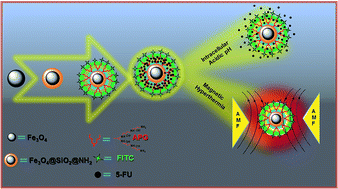Synthesis of amine-polyglycidol functionalised Fe3O4@SiO2 nanocomposites for magnetic hyperthermia, pH-responsive drug delivery, and bioimaging applications†
Abstract
The combined chemotherapy and thermal therapy is mainly considered in clinical applications in cancer therapy. However, the preparation of multifunctional nanomaterials is an attractive approach for cancer treatment. In this report, we present the synthesis of amine-polyglycidol functional shell modified-silica coated-magnetic iron oxide nanocomposites (Fe3O4@SiO2@APG-F) for a FITC conjugated drug carrier system and/or hyperthermia agent in cancer therapy. The Fe3O4@SiO2@APG-F nanocomposite exhibits superparamagnetic properties with a magnetic saturation value of approximately 17.2 emu g−1. The magnetic hyperthermia experiment shows a very fast temperature increase within a short time (45 °C in 4.5 min) when applying an alternating magnetic field (AMF), which is considered to be an appropriate temperature for the localized hyperthermia treatment in cancer therapy. Further, the fluorescein isothiocyanate (FITC), a model fluoropore, was conjugated with the terminal amine groups of the Fe3O4@SiO2@APG to endow the green fluorescent behavior that may be desirable for biological imaging applications. The Fe3O4@SiO2@APG-F material shows high drug loading efficiency and the MTT assay results evidenced that the synthesised Fe3O4@SiO2@APG-F nanocomposites are biocompatible. The fluorescence microscopic images show the particles can be effectively taken up by cancer cells. Therefore, the FITC conjugated Fe3O4@SiO2@APG-F nanocomposites that possess a magnetic core covered by silica coating, organic APG functional shell, and FITC fluorophore together in a single entity could serve as a good hyperthermia agent, drug delivery carrier, and fluorescent contrast agent for bioimaging. Thus, the Fe3O4@SiO2@APG-F nanocomposite could be considered as a promising material to be used in multimodal cancer therapy.



 Please wait while we load your content...
Please wait while we load your content...